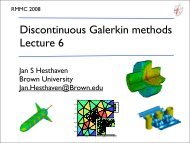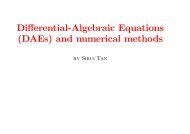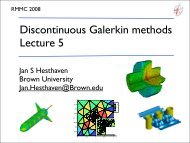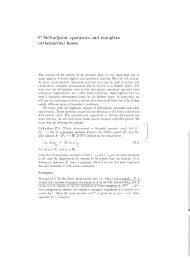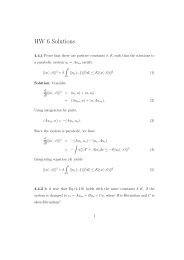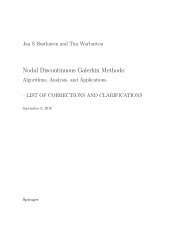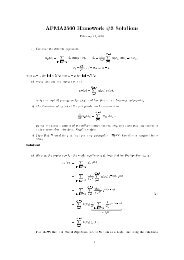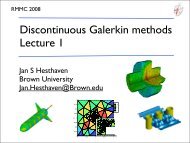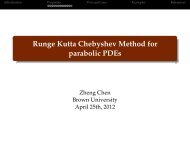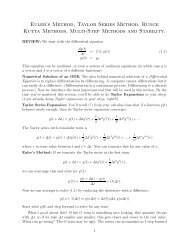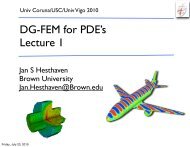MULTI-ELEMENT GENERALIZED POLYNOMIAL CHAOS FOR ...
MULTI-ELEMENT GENERALIZED POLYNOMIAL CHAOS FOR ...
MULTI-ELEMENT GENERALIZED POLYNOMIAL CHAOS FOR ...
Create successful ePaper yourself
Turn your PDF publications into a flip-book with our unique Google optimized e-Paper software.
918 XIAOLIANG WAN AND GEORGE EM KARNIADAKIS<br />
Table 3.2<br />
The indices of algebraic convergence of the basic stochastic ODE model. The algebraic indices<br />
are computed by the errors given by N =14and N =15. t =5.<br />
Beta distribution (case (i)) Gaussian distribution (case (ii))<br />
Mean Variance Mean Variance<br />
p =1 -3.95 -3.84 -3.90 -3.88<br />
p =2 -5.96 -5.87 -5.91 -5.90<br />
p =3 -7.96 -7.88 -7.59 -7.90<br />
Table 3.3<br />
A comparison between gPC, ME-gPC, and the standard Monte Carlo method for a fixed cost<br />
denoted by the number of floating point operations n. Beta distribution (case (i)) is considered and<br />
normalized errors are used. The first row with N =1corresponds to the gPC results.<br />
λ =1.0 λ =1.5<br />
n = 200 Error (mean) Error (var) Error (mean) Error (var)<br />
N =1,p =9 4.27e-12 7.84e-7 6.67e-9 1.95e-4<br />
N =4,p =4 2.84e-9 1.49e-6 1.20e-7 3.98e-5<br />
N = 25, p =1 5.88e-6 9.91e-5 2.95e-5 4.59e-4<br />
N = 100, p =0 4.16e-4 1.73e-3 9.36e-4 3.76e-3<br />
Monte Carlo 2.75e-1 5.13e-1 2.77e-1 8.31e-1<br />
achieve is of O(10 −13 ), which implies that the constructed orthogonal polynomials are<br />
very accurate.<br />
An obvious question that arises here is how well the kp-convergence of ME-gPC<br />
compares with the k-convergence or p-convergence. The answer is very dependent on<br />
the problem under consideration, since the properties of the solution, such as smoothness,<br />
may be significantly different. Given enough smoothness in the random space<br />
and a fixed time cost, p-convergence is usually a better choice than k-convergence<br />
or kp-convergence; however, kp-converge can be better than p-convergence for many<br />
cases. In the following we will measure computational complexity through n that<br />
indicates the number of operations. Using a standard gPC procedure with a Galerkin<br />
projection, we obtain the following deterministic equations for the coefficients of the<br />
polynomial chaos expansion of u(ζ):<br />
dui<br />
dt =<br />
1<br />
E[Φ 2 i (ζ)]<br />
ph�<br />
j=0 k=0<br />
p�<br />
hjukE[Φi(ζ)Φj(ζ)Φk(ζ)], i =0, 1,...,p,<br />
where ph and p indicate the highest polynomial orders of polynomial chaos expansions<br />
for h(ζ) and u(ζ), respectively. Then we can use n = N(ph +1)(p+1) 2 to measure the<br />
cost of ME-gPC, which is proportional to the number of operations of each time step<br />
if the Runge–Kutta method is employed for the integration in time. In Table 3.3 we<br />
present the accuracy of ME-gPC for different k and p while the cost is fixed (n = 200).<br />
We note that ph = 1. It can be seen that p-convergence is superior for the case λ =1.0.<br />
However, for a larger perturbation λ =1.5, the ME-gPC with N = p = 4 achieves a<br />
better accuracy of the variance than gPC. This implies that for a large perturbation<br />
the kp-convergence of ME-gPC can enhance the accuracy and efficiency significantly.<br />
From (2.39), it can be seen that the degree of perturbation is reduced in ME-gPC<br />
from O(λ) toO( bi−ai<br />
2 λ). Due to the fast (exponential) convergence of local gPC in<br />
each random element Bk, the overall performance of ME-gPC can be more efficient<br />
than that of gPC. We also expect that ME-gPC should be more robust than gPC for<br />
a large perturbation due to the decomposition of the random space. Furthermore, if



